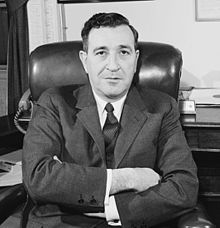Jerome Wiesner
Jerome Bert Wiesner (born May 30, 1915 in Detroit , Michigan , † October 21, 1994 in Watertown , Massachusetts ) was an American electrical engineer and science organizer. He was president of the Massachusetts Institute of Technology (MIT).
life and work
Wiesner grew up in Dearborn as the son of a shopkeeper. Even as a teenager he showed enthusiasm for technology and built his own telephone network with friends. He studied electrical engineering at the University of Michigan . In 1938 he completed his master’s degree there and received his doctorate there in 1950. In 1940 he was in the library of Congress acoustics laboratory and traveled with Alan Lomax through the southern states to record blues and folk musicians. From 1942 he worked at the MIT Radiation Laboratory on radar (as a group leader in the development of aircraft radar , Project Cadillac ) and he was also briefly in the Manhattan project in Los Alamos , where he built electronic components for atomic bombs. After the Second World War he stayed at MIT, where he was assistant professor in 1946, associate professor in 1947 and professor in 1950 and director of the Research Laboratory for Electronics (RLE) from 1952 to 1961. From 1959 to 1960 he headed the Faculty of Electrical Engineering. 1962 to 1971 he had the highest professorship at MIT (Institute Professor). In 1964 he became Dean of the School of Science at MIT, in 1966 Provost and from 1971 to 1980 he was President of MIT.
He was the adviser to several US presidents . Under the Kennedy administration, he was the President's Special Assistant for Science and Technology from 1961, which he remained until 1964; In the early years of Lyndon B. Johnson's presidency, he led the investigation following Rachel Carson's criticism (with her bestseller Silent Spring ) of the environmentally harmful widespread use of DDT . The Commission's report, published in 1963, recommended restricting the use of DDT and introducing environmental protection regulations. Wiesner was an active advocate of arms control and was instrumental in founding the Arms Control and Disarmament Agency in the Kennedy Administration and in the 1963 nuclear test ban agreement. From the late 1960s he was a critic of the United States planned missile defense systems . As early as 1958, he was a member of the Pugwash group and a US delegate to the Geneva Disarmament Conference . He continued his commitment to arms control in the 1980s (as an opponent of the Star Wars program) and 1990s.
In the late 1950s he sat down in the Eisenhower -Administration for ICBMs one. In 1961 he expressed himself very critical of NASA in a Wiesner report , wanted to radically curtail it and wanted to end the Mercury program for manned space travel. In the Apollo program , too , he opposed the landing method chosen in the end on the moon.
In 1948 he received the President's Certificate of Merit. In 1953 Wiesner was elected to the American Academy of Arts and Sciences and in 1969 to the American Philosophical Society . In 1980 he received the Delmer S. Fahrney Award and in 1993 the Public Welfare Medal of the National Academy of Sciences . He was a member of the National Academy of Sciences (since 1960) and the National Academy of Engineering . He was a multiple honorary doctor.
He was made a permanent member of MIT Corporation and a building at MIT was named after him.
In 1989 he suffered a stroke. He died of a heart attack. He was married and had three sons and a daughter. His son Stephen Wiesner is a physicist and a pioneer of quantum information theory.
Fonts
- Where science and politics meets , McGraw Hill 1961
- Hermann Volle, Helga Haftendorn (editor), Jerome Wiesner (foreword) Protection against surprise attacks in the nuclear age (selected documents from the Geneva Expert Conference 1958), Metzner 1962
- with Abram Chayes (editor) An evaluation of the decision to deploy and antiballistic missile system , Harper and Row 1969, German translation: Raketenkrieg. Expert opinions on the antiballistic missile defense system (ABM) , Propylaeen Verlag 1970
- with Kosta Tsipis , Philip Morrison The future of american defense , Scientific American, February 1994
- same: Beyond the Looking Glass: The United States Military in 2000 and Later , 1993
- On science advice to the president , Scientific American January 1989
Web links
Individual evidence
- ^ Members of the American Academy. Listed by election year, 1950-1999 ( [1] ). Retrieved September 23, 2015
- ↑ Member History: Jerome B. Wiesner. American Philosophical Society, accessed November 17, 2018 .
| personal data | |
|---|---|
| SURNAME | Wiesner, Jerome |
| ALTERNATIVE NAMES | Wiesner, Jerome Bert (full name); Wiesner, Jerome B .; Wiesner, Jerry |
| BRIEF DESCRIPTION | American electrical engineer and science organizer |
| DATE OF BIRTH | May 30, 1915 |
| PLACE OF BIRTH | Detroit , Michigan |
| DATE OF DEATH | October 21, 1994 |
| Place of death | Watertown , Massachusetts |

